Sub-Seasonal Prediction of the Maritime Continent Rainfall of Wet-Dry Transitional Seasons in the NCEP Climate Forecast Version 2
Abstract
:1. Introduction
2. Model and Data
3. Prediction of MC Rainfall of the Transitional Periods between Wet and Dry Seasons in LD0
3.1. Major Features in Observation

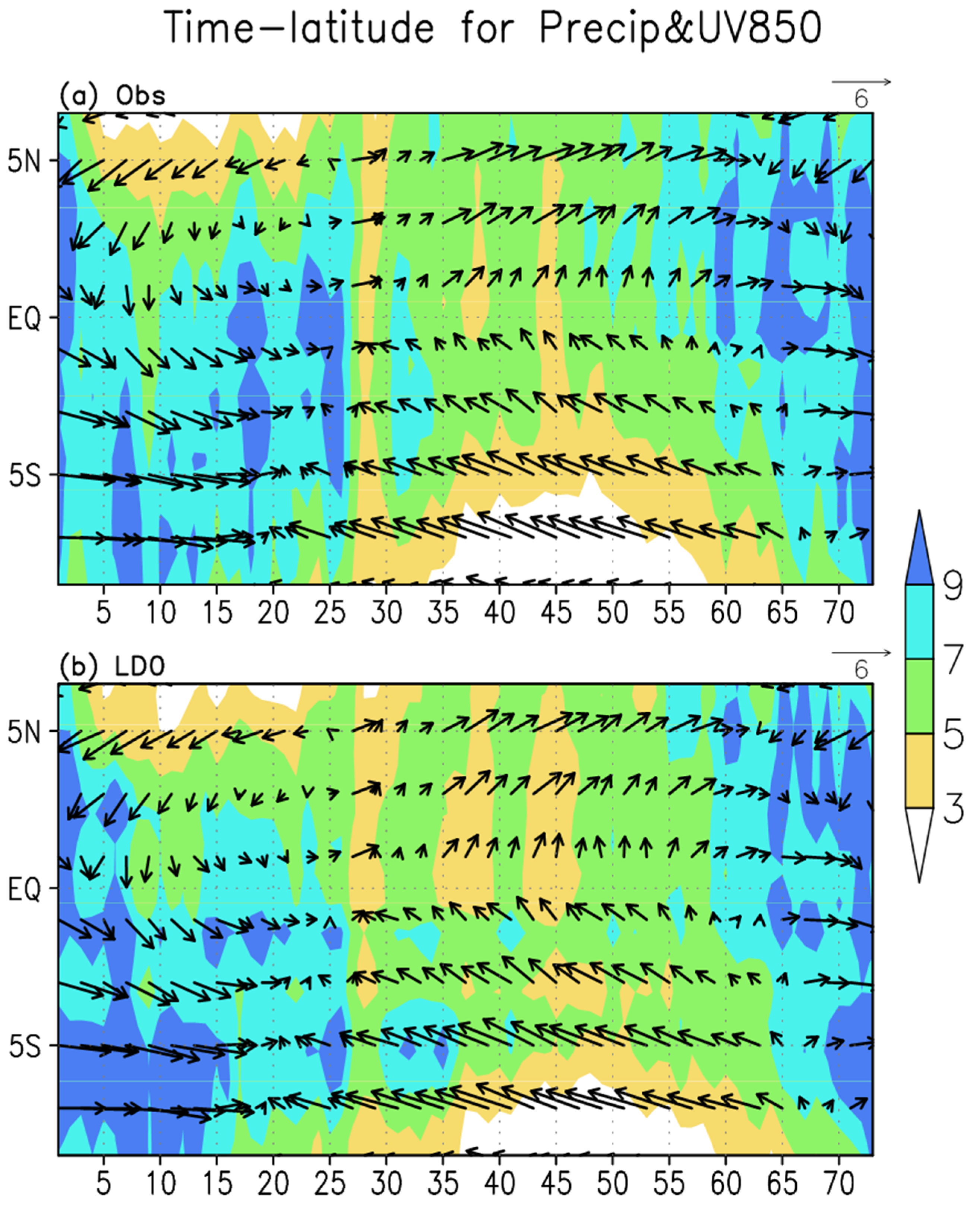
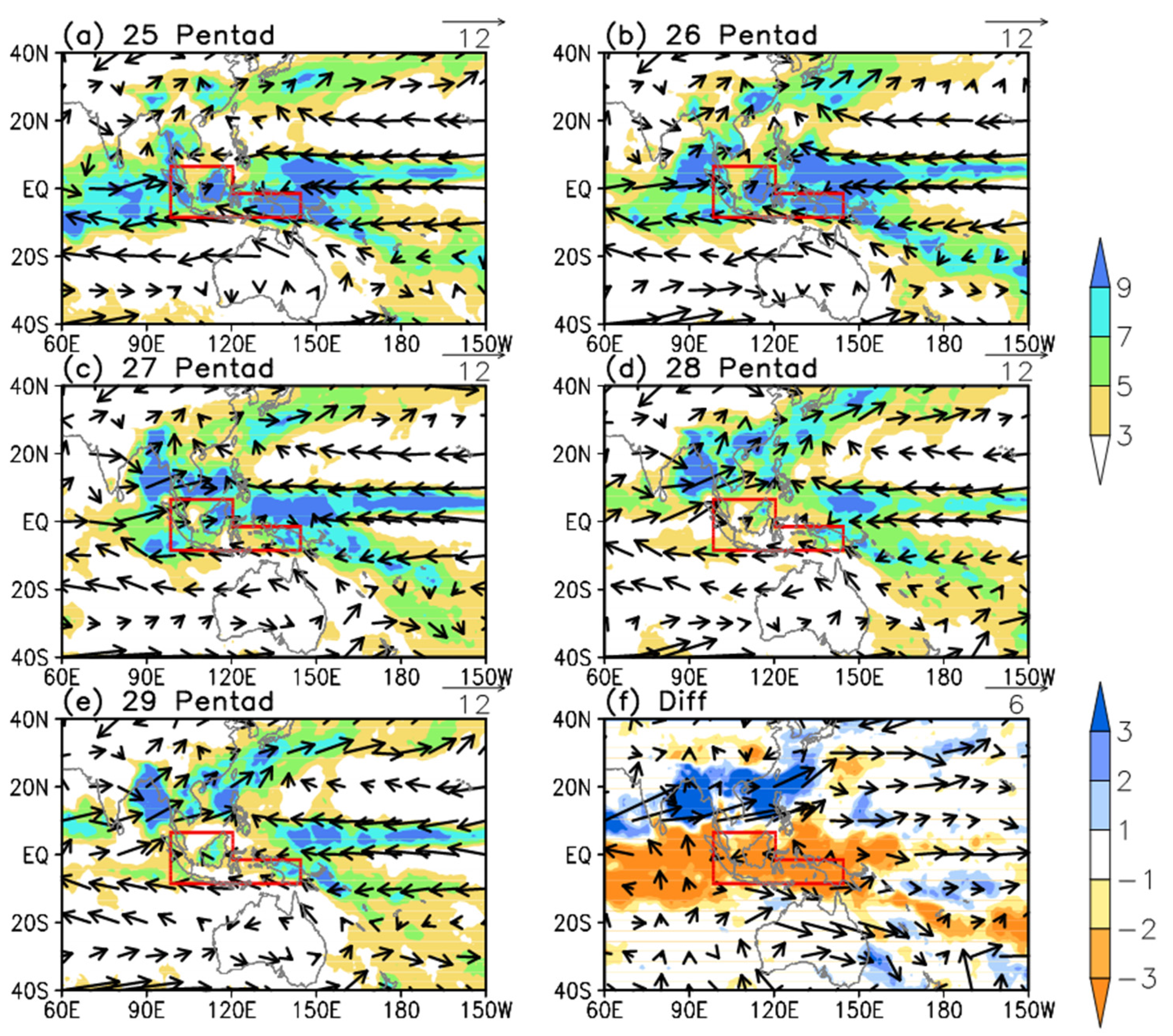


3.2. Prediction in LD0
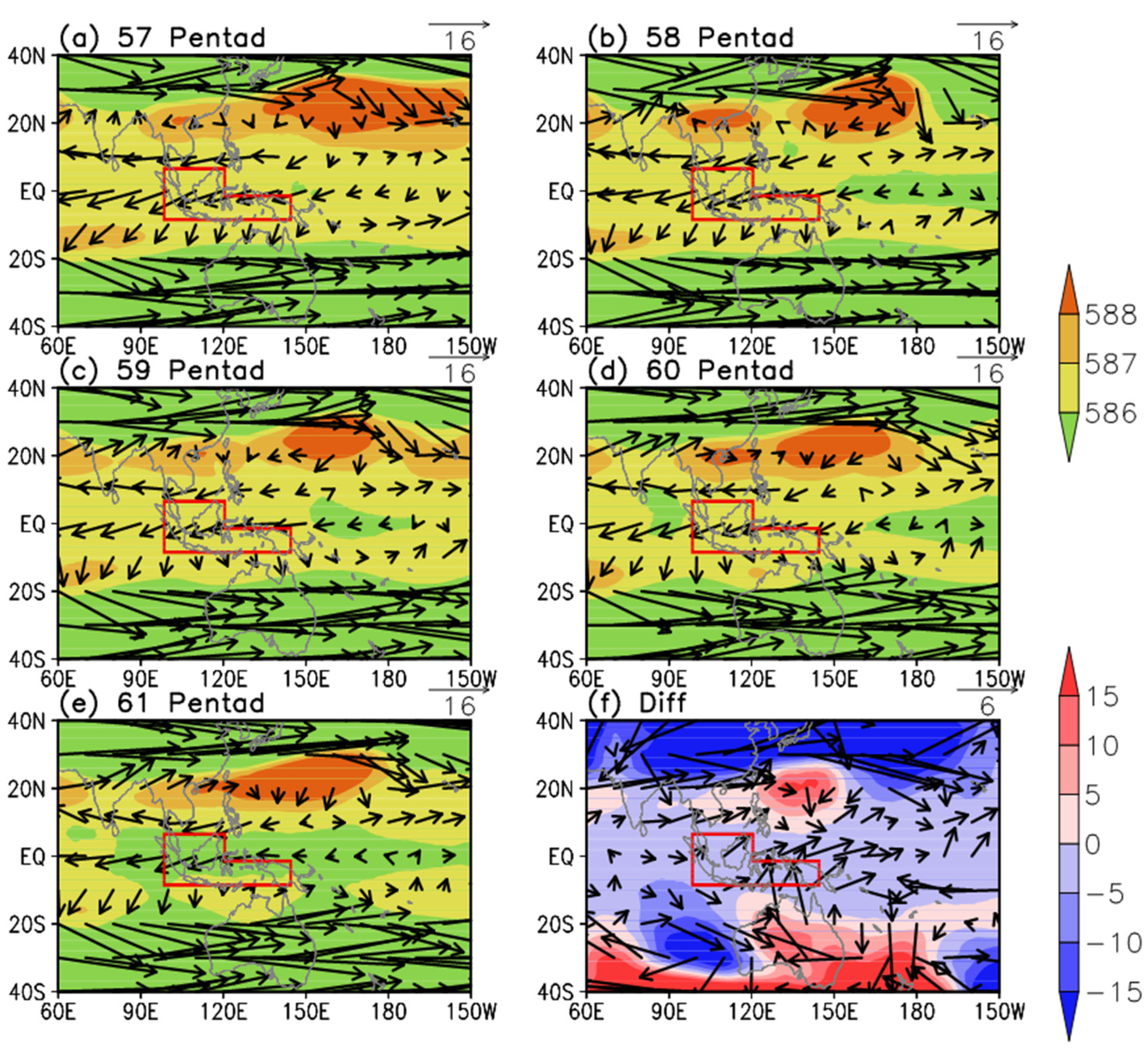

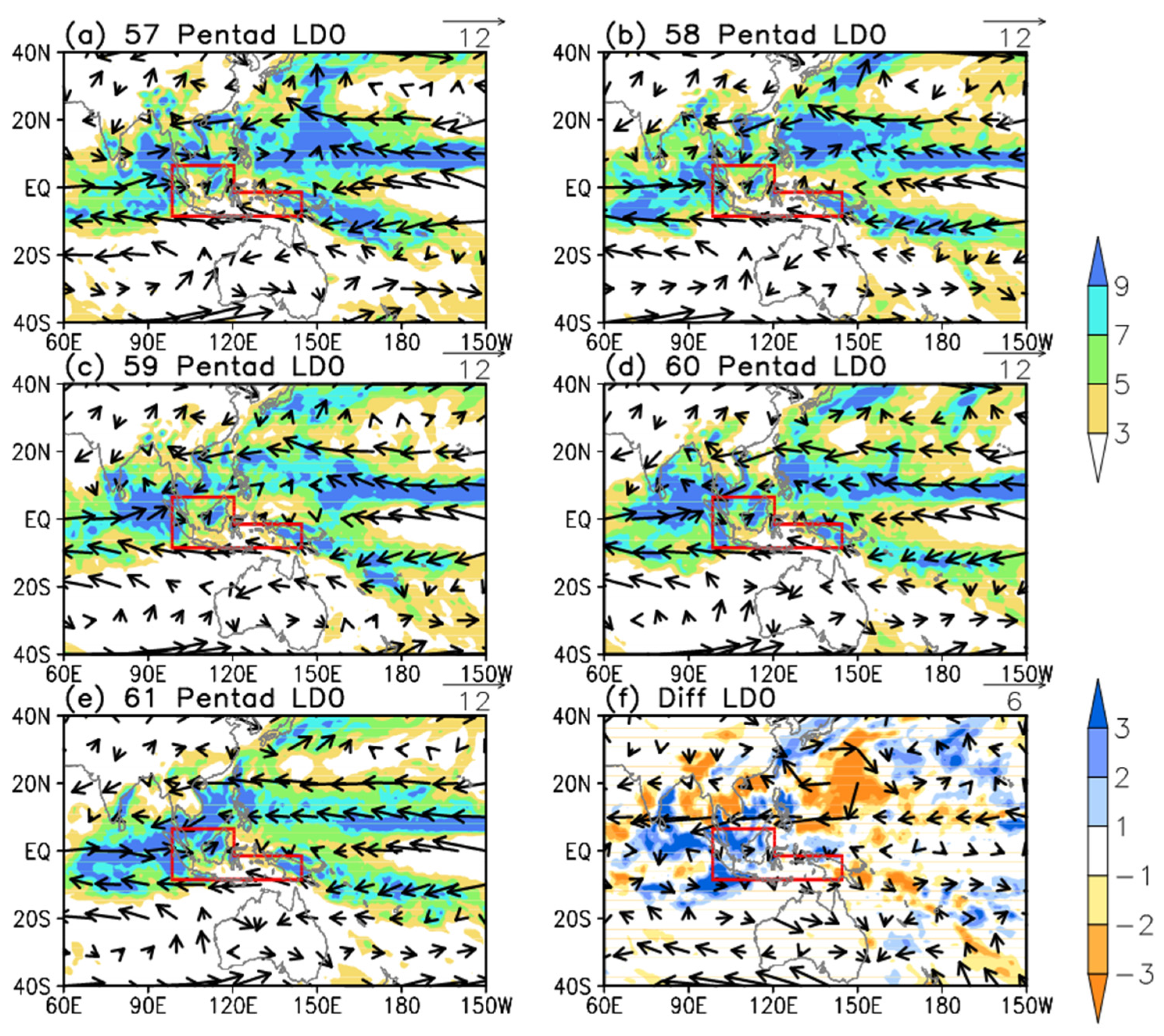
4. Prediction of MC Rainfall and Associated Circulation Patterns in Different Leads of Time


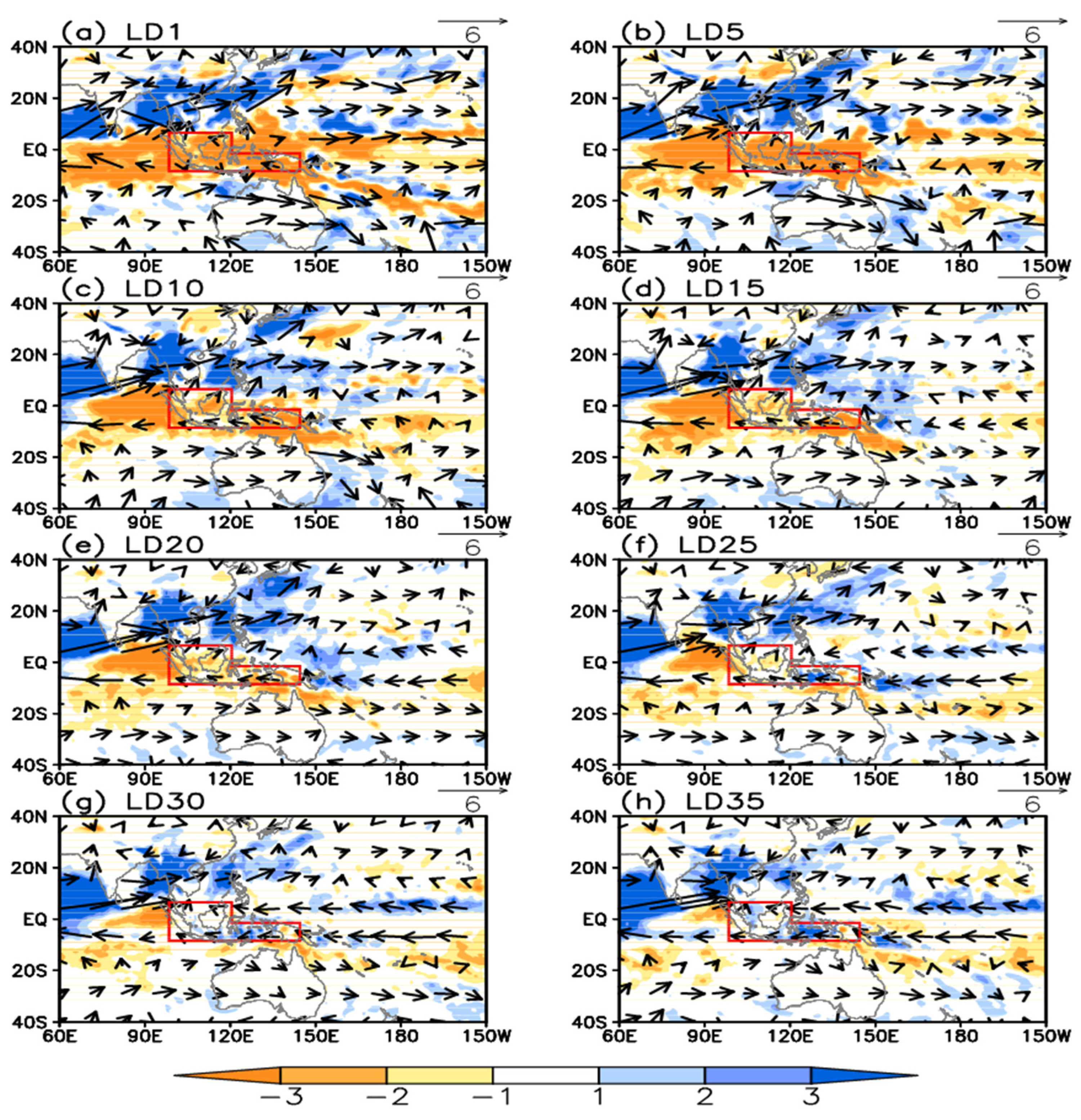
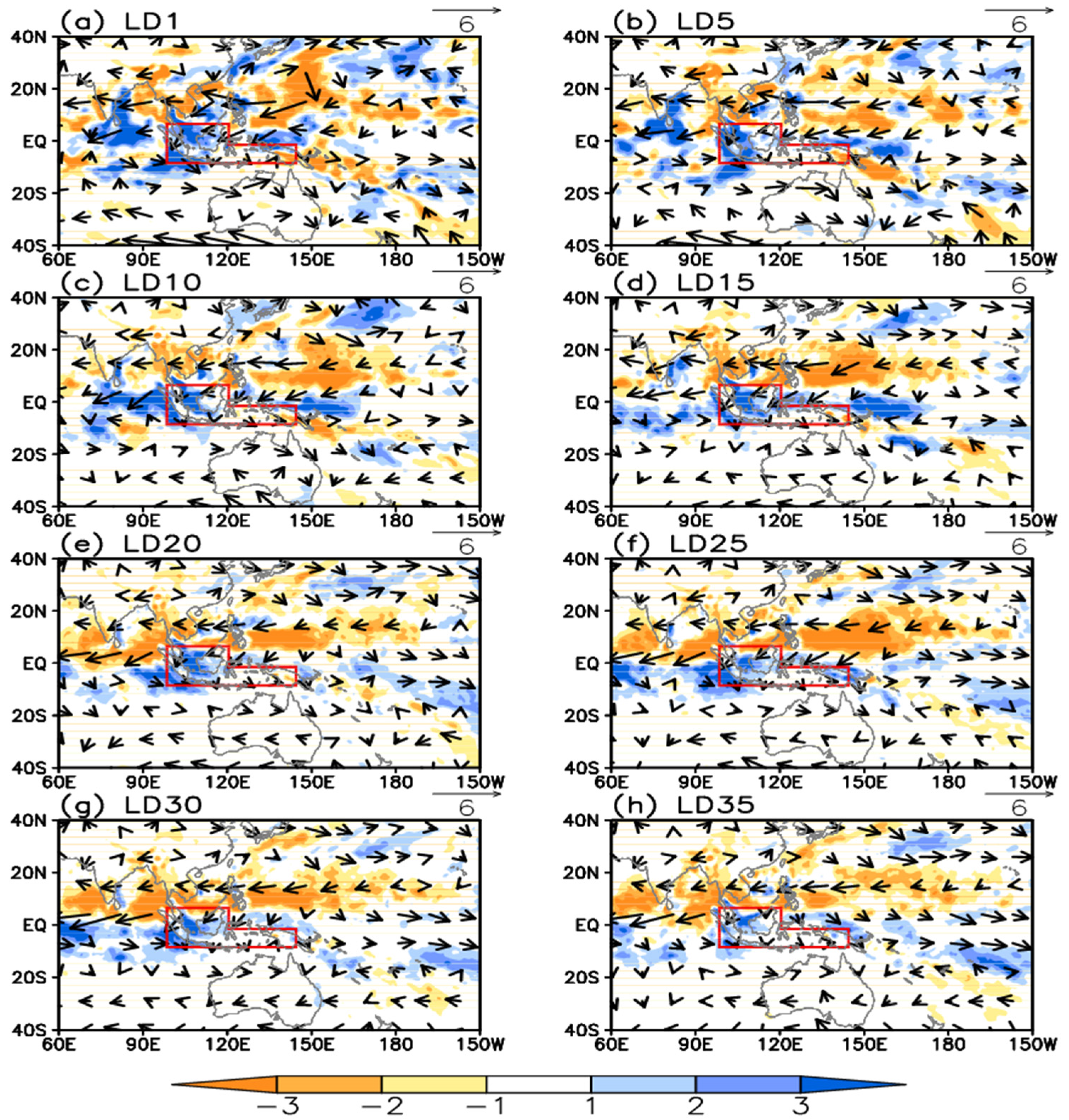

5. Discussion and Conclusions
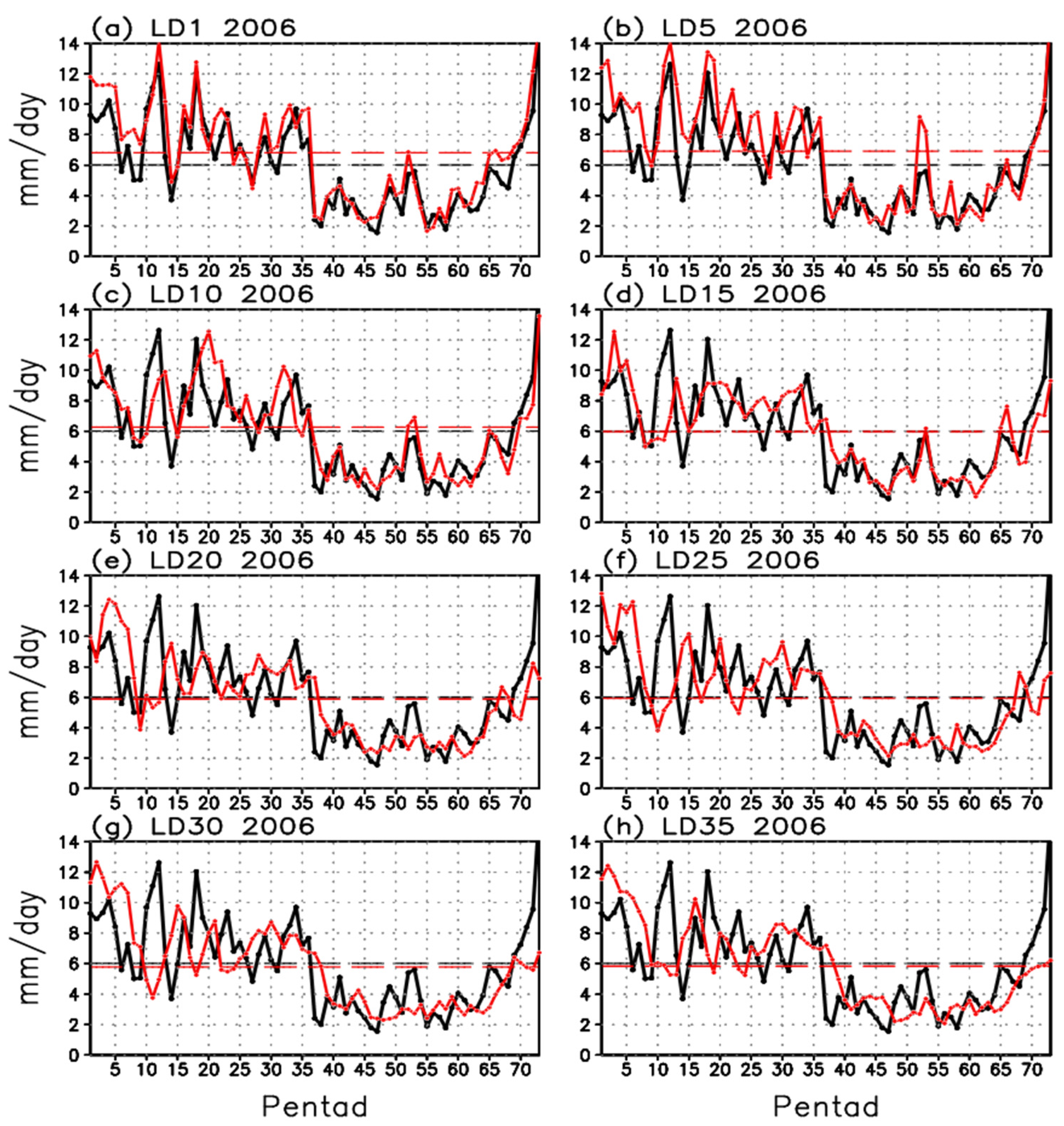
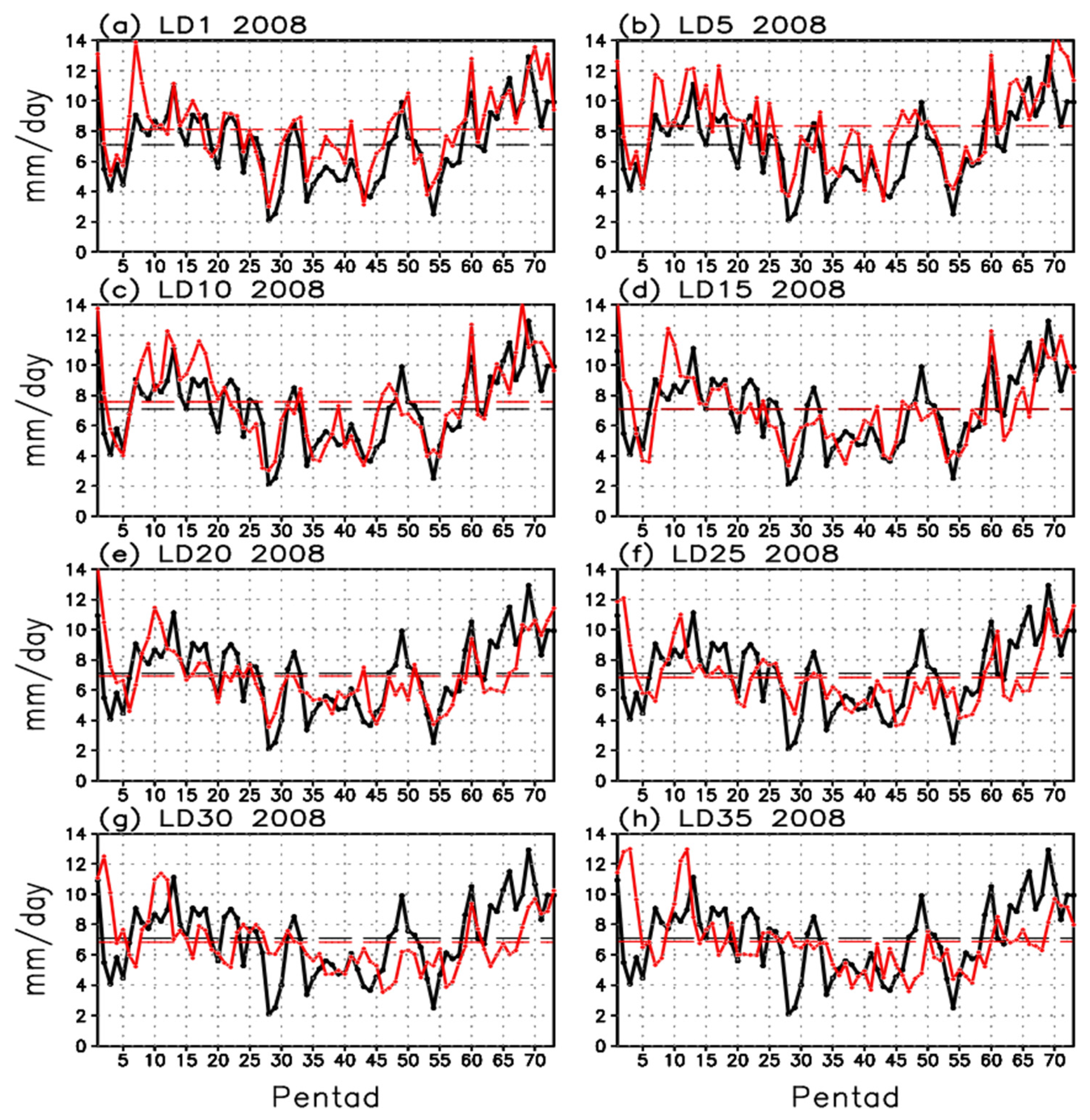
Acknowledgments
Author Contributions
Conflicts of Interest
References
- Chang, C.-P.; Wang, Z.; McBride, J.; Liu, C. Annual cycle of southeast Asia-Maritime Continent rainfall and the asymmetric monsoon transition. J. Clim. 2005, 18, 287–301. [Google Scholar] [CrossRef]
- Lau, K.-M.; Chang, C.-P.; Chan, P.H. Short-term planetary-scale interactions over the tropics and midlatitudes. Part II: Winter MONEX period. Mon. Weather Rev. 1983, 111, 1372–1388. [Google Scholar] [CrossRef]
- Meehl, G.A. The annual cycle and interannual variability in the tropical Pacific and Indian Ocean regions. Mon. Weather Rev. 1987, 115, 27–50. [Google Scholar] [CrossRef]
- Matsumoto, J. The seasonal changes in Asian and Australian monsoon regions. J. Meteorol. Soc. Jpn. 1992, 70, 257–273. [Google Scholar]
- Matsumoto, J.; Murakami, T. Seasonal migration of monsoons between the Northern and Southern Hemispheres as revealed from equatorially symmetric and asymmetric OLR data. J. Meteorol. Soc. Jpn. 2002, 80, 419–437. [Google Scholar] [CrossRef]
- Yasunari, T. The monsoon year—A new concept of the climatic year in the Tropics. Bull. Am. Meteorol. Soc. 1991, 72, 1331–1338. [Google Scholar] [CrossRef]
- Ramage, C.S. Role of a tropical “Maritime Continent” in the atmospheric circulation. Mon. Weather Rev. 1968, 96, 365–369. [Google Scholar] [CrossRef]
- Qian, J.H. Why rainfall is mostly concentrated over islands in the Maritime Continent. J. Atmos. Sci. 2008, 65, 1428–1441. [Google Scholar] [CrossRef]
- Simpson, J.; Keenan, T.D.; Ferrier, B.; Simpson, R.H.; Holland, G.J. Cumulus merger in the Maritime Continent region. Meteorol. Atmos. Phys. 1993, 51, 73–99. [Google Scholar] [CrossRef]
- Hastenrath, S.; Lamb, P.J. Climate dynamics of atmosphere and ocean in the equatorial zone: A synthesis. Int. J. Climatol. 2004, 24, 1601–1612. [Google Scholar] [CrossRef]
- Agudelo, P.A.; Curry, J.A.; Hoyos, C.D.; Webster, P.J. Transition between suppressed and active phases of intraseasonal oscillations in the Indo-Pacific warm pool. J. Clim. 2006, 19, 5519–5530. [Google Scholar] [CrossRef]
- McBride, J.L.; Nicholls, N. Seasonal relationships between Australian rainfall and the Southern Oscillation. Mon. Weather Rev. 1983, 111, 1998–2004. [Google Scholar] [CrossRef]
- McBride, J.L.; Haylock, M.R.; Nicholls, N. Relationships between the Maritime Continent heat source and the El Niño-Southern Oscillation phenomenon, J. Clim. 2003, 16, 2905–2914. [Google Scholar] [CrossRef]
- Yang, G.-Y.; Slingo, J. The diurnal cycle in the tropics. Mon. Weather Rev. 2001, 129, 784–801. [Google Scholar] [CrossRef]
- Keenan, T.D.; Rutledge, S.A.; Carbone, R.E.; Wilson, J.W.; Takahashi, T.; May, P.; Tapper, N.; Platt, M.; Hacker, J.M.; Sekelsky, S.M.; et al. The Maritime Continent Thunderstorm Experiment (MCTEX): Overview and some results. Bull. Am. Meteorol. Soc. 2000, 81, 2433–2455. [Google Scholar] [CrossRef]
- Keenan, T.D.; Morton, B.R.; Manton, M.J.; Holland, G.J. The Island Thunderstorm Experiment (ITEX): A study of tropical thunderstorms in the Maritime Continent. Bull. Am. Meteorol. Soc. 1989, 70, 152–159. [Google Scholar] [CrossRef]
- Inness, P.M.; Slingo, J.M. The interaction of the MJO with the Maritime Continent in a GCM. Q. J. R. Meteorol. Soc. 2006, 132, 1645–1667. [Google Scholar] [CrossRef]
- Chang, C.-P.; Lau, K.-M. Short-term planetary-scale interactions over the tropics and midlatitudes during northern winter. Part I: Contrasts between active and inactive periods. Mon. Weather Rev. 1982, 110, 933–946. [Google Scholar] [CrossRef]
- Chang, C.-P.; Harr, P.A.; Chen, H.-J. Synoptic disturbances over the equatorial South China Sea and western Maritime Continent during boreal winter. Mon. Weather Rev. 2005, 133, 489–503. [Google Scholar] [CrossRef]
- Slingo, J.M.; Inness, P.M.; Neale, R.B.; Woolnough, S.J.; Yang, G.Y. Scale interactions on diurnal to seasonal timescales and their relevance to model systematic errors. Ann. Geophys. 2003, 46, 139–155. [Google Scholar]
- Sui, C.H.; Lau, K.M. Multiscale phenomena in the tropical atmosphere over the Western Pacific. Mon. Weather Rev. 1992, 120, 407–430. [Google Scholar] [CrossRef]
- Zhu, B.; Wang, B. The 30–60-day convection seesaw between the tropical Indian and western Pacific oceans. J. Atmos. Sci. 1993, 50, 184–199. [Google Scholar] [CrossRef]
- Zhang, Y.; Sperber, K.S.; Boyle, J.S. Climatology and interannual variation of the East Asia winter monsoon: Results from the 1979–95 NCEP/NCAR Reanalysis. Mon. Weather Rev. 1997, 125, 2605–2619. [Google Scholar] [CrossRef]
- Park, T.-W.; Ho, C.-H.; Yang, S. Relationship between the Arctic Oscillation and cold surges over East Asia. J. Clim. 2011, 24, 68–83. [Google Scholar] [CrossRef]
- Holland, G.J.; Keenan, T.D. Diurnal variations of convection over the “Maritime Continent”. Mon. Weather Rev. 1980, 108, 223–225. [Google Scholar] [CrossRef]
- McBride, J.L. Tropical Cyclone Formation. Global Perspective on Tropical Cyclones; Elsberry, R.L., Ed.; Tech. Doc. 693; World Meteorological Organization: Geneva, Switzerland, 1995; pp. 63–105. [Google Scholar]
- Inness, P.M.; Slingo, J.M.; Guilyardi, E.; Cole, J. Simulation of Madden-Julian Oscillation in a coupled general circulation model. Part II: The role of the basic state. J. Clim. 2003, 16, 365–382. [Google Scholar] [CrossRef]
- Hendon, H.H. Indonesian rainfall variability: Impacts of ENSO and local air-sea interaction. J. Clim. 2003, 16, 1775–1790. [Google Scholar] [CrossRef]
- Haylock, M.; McBride, J. Spatial coherence and predictability of Indonesian wet season rainfall. J. Clim. 2001, 14, 3882–3887. [Google Scholar] [CrossRef]
- Horel, J.D.; Wallace, J.M. Planetary scale atmospheric phenomena associated with the Southern Oscillation. Mon. Weather Rev. 1981, 109, 813–829. [Google Scholar] [CrossRef]
- Zhang, T.; Yang, S.; Jiang, X.; Zhao, P. Seasonal-interannual variation and prediction of wet and dry season rainfall over the Maritime Continent: Roles of ENSO and monsoon circulation. J. Clim. 2015. [Google Scholar] [CrossRef]
- Aldrian, E.; Gates, L.D.; Widodo, F.H. Seasonal variability of Indonesia rainfall in ECHAM4 simulations and in the reanalyses: The role of ENSO. Theor. Appl. Climatol. 2007, 87, 41–59. [Google Scholar] [CrossRef]
- Hung, C.-W.; Yanai, M. Factors contributing to the onset of the Australian summer monsoon. Q. J. R. Meteorol. Soc. 2004, 130, 739–761. [Google Scholar] [CrossRef]
- Hung, C.-W.; Liu, X.; Yanai, M. Symmetry and asymmetry of the Asian and Australian summer monsoons. J. Clim. 2004, 17, 2413–2426. [Google Scholar] [CrossRef]
- Li, T.; Philander, S.G.H. On the annual cycle of the eastern equatorial Pacific. J. Clim. 1996, 9, 2986–2998. [Google Scholar] [CrossRef]
- Wang, B. On the annual cycle in the tropical eastern and central Pacific. J. Clim. 1994, 7, 1926–1942. [Google Scholar] [CrossRef]
- Webster, P.J.; Palmer, T.; Yanai, M.; Tomas, R.; Magana, V.; Shukla, J.; Yasunari, T. Monsoons: Processes, predictability and the prospects for prediction. J. Geophys. Res. 1998, 103, 14451–14510. [Google Scholar] [CrossRef]
- Matsumoto, J.; Murakami, T. Annual changes of tropical convective activities as revealed from equatorial symmetric OLR data. J. Meteorol. Soc. Jpn. 2000, 78, 543–561. [Google Scholar]
- Jiang, X.; Li, J. Influence of the annual cycle of SST on the monsoon onset. J. Geophys. Res. 2011, 116, D10105. [Google Scholar] [CrossRef]
- Neale, R.; Slingo, J. The Maritime Continent and its role in the global climate: A GCM study. J. Clim. 2003, 16, 834–848. [Google Scholar] [CrossRef]
- Jiang, X.; Yang, S.; Li, Y.; Kumar, A.; Wang, W.; Gao, Z. Dynamical prediction of the East Asian winter monsoon by the NCEP Climate Forecast System. J. Geophys. Res. 2013, 118, 1312–1328. [Google Scholar] [CrossRef]
- Jiang, X.; Li, Y.; Yang, S.; Shu, J.; He, G. Interannual variation of mid-summer heavy rainfall in the eastern edge of the Tibetan Plateau. Clim. Dyn. 2015. [Google Scholar] [CrossRef]
- Hackert, E.C.; Hastenrath, S. Mechanisms of Java rainfall anomalies. Mon. Weather Rev. 1986, 114, 745–757. [Google Scholar] [CrossRef]
- Nicholls, N. A simple air-sea interaction model. Q. J. R. Meteorol. Soc. 1979, 105, 93–105. [Google Scholar] [CrossRef]
- Wild, M.; Roeckner, E. Radiative fluxes in the ECHAM5 General Circulation Model. J. Clim. 2006, 19, 3792–3809. [Google Scholar] [CrossRef]
- Mori, S.; Hamada, J.I.; Tauhid, Y.I.; Yamanaka, M.D.; Okamato, N.; Murata, F.; Sakurai, N.; Hashiguchi, H.; Sribimawati, T. Diurnal land-sea rainfall peak migration over Sumatera Island, Indonesian Maritime Continent, observed by TRMM satellite and intensive rawinsonde soundings. Mon. Weather Rev. 2004, 132, 2021–2039. [Google Scholar] [CrossRef]
- Ichikawa, H.; Yasunari, T. Time-space characteristics of diurnal rainfall over Borneo and surrounding oceans as observed by TRMMPR. J. Clim. 2006, 19, 1238–1260. [Google Scholar] [CrossRef]
- Rauniyar, S.P.; Walsh, K.J.E. Influence of ENSO on the diurnal cycle of rainfall over the Maritime Continent and Australia. J. Clim. 2012, 26, 1304–1321. [Google Scholar] [CrossRef]
- Madden, R.A.; Julian, P.R. Detection of a 40–50 day oscillation in the zonal wind in the tropical Pacific. J. Atmos. Sci. 1971, 28, 702–708. [Google Scholar] [CrossRef]
- Kim, H.-M.; Webster, P.J.; Toma, V.E.; Kim, D. Predictability and prediction skill of the MJO in two operational forecasting systems. J. Clim. 2014, 27, 5364–5378. [Google Scholar] [CrossRef]
- Wang, W.; Hung, M.-P.; Weaver, S.J.; Kumar, A.; Fu, X. MJO prediction in the NCEP Climate Forecast System version 2. Clim. Dyn. 2014, 42, 2509–2520. [Google Scholar] [CrossRef]
- Zhang, Q.; Dool, H. Relative merit of model improvement versus availability of retrospective forecasts: The case of Climate Forecast System MJO prediction. Weather Forecast. 2012, 27, 1045–1051. [Google Scholar] [CrossRef]
- Saha, S.; Moorthi, S.; Wu, X.; Wang, J.; Nadiga, S.; Tripp, P.; Behringer, D.; Hou, Y.T.; Chuang, H.Y.; Iredell, M.; Ek, M. The NCEP Climate Forecast System Version 2. J. Clim. 2013, 27, 2185–2208. [Google Scholar] [CrossRef]
- Saha, S.; Nadiga, S.; Thiaw, C.; Wang, J.; Wang, W.; Zhang, Q.; van den Dool, H.M.; Pan, H.L.; Moorthi, S.; Behringer, D.; et al. The NCEP Climate Forecast System. J. Clim. 2006, 19, 3483–3517. [Google Scholar] [CrossRef]
- Saha, S.; Moorthi, S.; Pan, H.L.; Wu, X.; Wang, J.; Nadiga, S.; Tripp, P.; Kistler, R.; Woollen, J.; Behringer, D.; et al. The NCEP Climate Forecast System Reanalysis. Bull. Am. Meteorol. Soc. 2010, 91, 1015–1057. [Google Scholar] [CrossRef]
- Moorthi, S.; Pan, H.-L.; Caplan, P. Changes to the 2001 NCEP Operational MRF/AVN Global Analysis/Forecast System, 1st ed.US Department of Commerce, National Oceanic and Atmospheric Administration, National Weather Service, Office of Meteorology, Program and Plans Division: Silver Spring, MD, USA, 2001; pp. 1–14.
- Ek, M.B.; Mitchell, K.E.; Lin, Y.; Rogers, E.; Grunmann, P.; Koren, V.; Gayno, G.; Tarpley, J.D. Implementation of Noah land surface model advances in the national centers for environmental prediction operational mesoscale eta model. J. Geophys. Res. 2003, 108–8851. [Google Scholar] [CrossRef]
- Griffies, S.M.; Harrison, M.J.; Pacanowsky, R.C.; Rosati, A. A Technical Guide to MOM4. GFDL Ocean Group Technical Report 5; NOAA/GFDL: Princeton, NJ, USA, 2003; p. 295.
- Kalnay, E.; Kanamitsu, M.; Kistler, R.; Collins, W.; Deaven, D.; Gandin, L.; Iredell, M.; Saha, S.; White, G.; Woollen, J.; et al. The NCEP/NCAR 40-year reanalysis project. Bull. Am. Meteorol. Soc. 1996, 77, 437–471. [Google Scholar] [CrossRef]
- Adler, R.F.; Huffman, G.J.; Chang, A.; Ferraro, R.; Xie, P.P.; Janowiak, J.; Rudolf, B.; Schneider, U.; Curtis, S.; Bolvin, D.; et al. The version 2 Global Precipitation Climatology Project (GPCP) Monthly Precipitation Analysis (1979–present). J. Hydrometeor. 2003, 4, 1147–1167. [Google Scholar] [CrossRef]
- Wang, B.; Ho, L. Rainy season of the Asian–Pacific summer monsoon. J. Clim. 2001, 15, 386–398. [Google Scholar] [CrossRef]
© 2016 by the authors; licensee MDPI, Basel, Switzerland. This article is an open access article distributed under the terms and conditions of the Creative Commons by Attribution (CC-BY) license (http://creativecommons.org/licenses/by/4.0/).
Share and Cite
Zhang, T.; Yang, S.; Jiang, X.; Dong, S. Sub-Seasonal Prediction of the Maritime Continent Rainfall of Wet-Dry Transitional Seasons in the NCEP Climate Forecast Version 2. Atmosphere 2016, 7, 28. https://doi.org/10.3390/atmos7020028
Zhang T, Yang S, Jiang X, Dong S. Sub-Seasonal Prediction of the Maritime Continent Rainfall of Wet-Dry Transitional Seasons in the NCEP Climate Forecast Version 2. Atmosphere. 2016; 7(2):28. https://doi.org/10.3390/atmos7020028
Chicago/Turabian StyleZhang, Tuantuan, Song Yang, Xingwen Jiang, and Shaorou Dong. 2016. "Sub-Seasonal Prediction of the Maritime Continent Rainfall of Wet-Dry Transitional Seasons in the NCEP Climate Forecast Version 2" Atmosphere 7, no. 2: 28. https://doi.org/10.3390/atmos7020028
APA StyleZhang, T., Yang, S., Jiang, X., & Dong, S. (2016). Sub-Seasonal Prediction of the Maritime Continent Rainfall of Wet-Dry Transitional Seasons in the NCEP Climate Forecast Version 2. Atmosphere, 7(2), 28. https://doi.org/10.3390/atmos7020028





